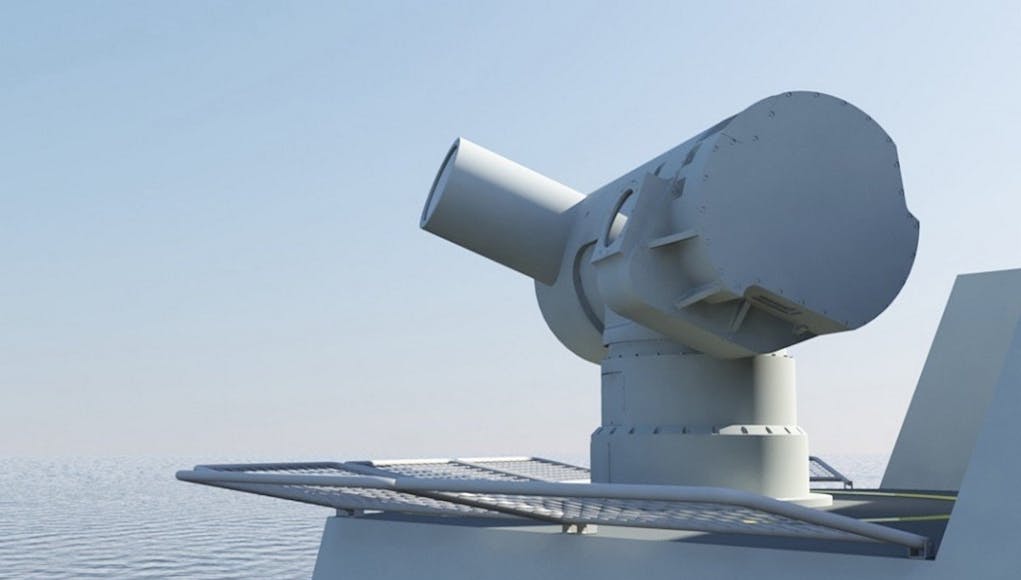Qinetiq have discussed the schedule for the testing of ‘Dragonfire’ a new British laser directed energy weapon.
The first project to be undertaken at the new Dragonworks laser test facility will be the assembly and testing of the laser directed energy weapon (LDEW) currently in development by the UK’s Dragonfire consortium.
Components arrived in early 2018 and QinetiQ will started building the weapon’s laser source in the purpose-built clean room. Over the following months, the laser source will undergo a process of evaluation and adjustment before being integrated with Leonardo’s beam director.
The project will culminate in operation at full-power under test conditions inside the facility in summer 2018, before it is transported to MOD Shoeburyness for long-range outdoor trials later in the year.

Data collected using the Reflective Hazard Assessment Tool will inform the safety case for these and future trials, ensuring the reflectivity of targets is fully understood and any risk mitigated accordingly.
Peter Cooper, the Project Technical Authority in Dstl, which manages the Dragonfire contract on behalf of the UK MOD, said regarding the new test facility:
“This facility is a key step in delivering the Dragonfire project and reflects the continuing UK MOD investment, supported and enabled by industry funding, amounting to tens of millions of pounds in UK industrial skills and capabilities and underpinning UK prosperity.”














Good news…yet another step forward.
i’d hope that with british skills and innovation that, the u.k will be at the vanguard of projects like laser weaponry. places like the u.s should not be allowed to get ahead of the european programmes.
Great news following the new sea captor and viper building up.a very good range of fire power
Fantastic, can’t wait to see this up and running!
Watch out Alderaan!
Like Taranis though, will we actually buy the thing or develop it then let others reap the dividends?
The real story here is the test facility.
On this one I must admit I remain sceptical. I welcome the news of further testing but I’ll believe it when I see it actually installed on a British warship.
I am with you on this one.
The use of energy weapons in the maritime environment comes with a whole host of issues that are not found in a purely land environment.
As the USN has found testing a laser at altitude in the clear dry desert air of white sands testing range is not the same as a wet and windy day at sea level.
Shoeburyness should be an ideal location to test in that case.
http://shoeburyness.qinetiq.com/
Sceptical by name Sceptical by nature
Would a laser be effective against ballistic or hypersonic targets? if an weapon that uses materials that can withstand re-entry or the heat generated in hypersonic flight would a laser be able to focus long enough to penetrate? From test videos I’ve seen of the US systems they need to focus for a few seconds on a target before it penetrates the skin, and those were slow moving UAVs.
In theory yes. Practice is another thing. It’s all about getting sufficient energy, for long enough, accurately on target. And you’re right. Things that are designed to resist huge reentry temperatures or hypersonic flight will be more difficult to destroy. The maritime environment also is not conducive to good laser propagation, certainly over large distances. So, pumping out sufficient power is one issue. Getting that power to focus accurately on target for long enough is another. A guidance system which is accurate enough to place a missile within proximity fuse range of a target may not be accurate enough to lay a laser beam for long enough onto a small, fleeting target, at range. Technology is improving all the time but I don’t see this as a viable principal weapon system yet. Far from it. Missiles will still have a role for many years to come.
Who cares about the technical stuff it’s the got Dragonfire!!!
🙂
So low end threats where a you get more bang for buck, far cheaper than a guided round or missiles. But you would need more than on system per hull to fend off low end swarm attacks if the engagement time per target is too long.
If you pulse a laser on a target at a few hundred pulses a second the energy “hammers” against the surface causing damage. That way keeping the beam super accurately on target to burn through is not needed.
If you are targeting electro optics or ir homing sensors you will have better luck
Still doesn’t help that there are really bad absorption windows , spray, mist and water drop keys to absorb the beam before it even reaches the target.
Yes, let’s not be too pessimistic about this. Not a principal weapon. But yes to replace or sit alongside Phalanx and the 30mm gun mounts.
The biggest problem we have seen when testing these weapons is actually the targeting systems which have proven incredibly slow (in relative terms). It is only in very recent times that these have finally caught up and are improving on a weekly basis. The technology actually uses seed lasers which when combined use massive peak power. This of course has its own issues such as power supply which when static is no issue but when fitted to something like a ship, is problematic.
Would lasers really be effective over any range on a ship? The US gave up on airborne lasers because of the massive power requirements to be effective. Yes a ship should be able to provide the power, but again, at sea level, on a damp wet day with limited visibility, on a moving ship, the technical challenges are huge.
Will this replace CIWS(phalanx), or accompany it?
Why hasn’t this been done before! the technology has been around for a while. I suspect many manufacturers don’t want to stop selling us missiles. The Dyson factor!
The tech has not been around. Yes we have had powerful lasers but they have been very temperamental and huge. The tech is now getting to the point that these can be made to be resilient and much smaller.
The Brahmos 11 travelling at Mach 7 will provide about a SIX second window to detect, track a jinking vampire and burn thru heat resistent missile skins with beam that may be severely degraded by sea spray. Easy, no problemo.
Also Phalanx would be next to useless, it could engage in the last second of flight and if the missile was to gain just a few metres of altitude then even if Phalanx hit the missile its altitude and momentum means hypersonic debris would still hit the ship causing serious damage
Rail guns may provide a better defence against Hypersonic targets. When you consider a fragment of paint nearly went through the window of the ISS then a fragmenting round from a rail gun with combined speed of 10000mph could take out a hypersonic target, if the radar could detect it in time.
I’m sure I read somewhere that BAE/US DoD has shut down it’s rail gun project…
Brahmos 2 won’t be going at M7.0 at sea level….
Althoughh I cannot give up too information, I work fo a UK laser company that provided technology for QuinetiQ for this weapon. Please feel confident that a huge amount of effort has been designed, developed and tested and I belive it WILL be part of the arnament on our ships, aircraft and vehicles in the near future. We have also provided lasers to DARPA, DOD (via Raytheon) and even have plans to send them to the Space Station. The UK are world leaders in such technology. The future is bright. The future is British.
Hi JimmyTwoShoes Its very good news that the UK government finally commits to LaWS; really do need to play catch up though. The DOD did studies on what kinds of power levels are needed in order to mitigate against high-speed missiles, and now we are in the territory of hypersonic anti-ship missiles.
None the less, looking forward to seeing LaWS as a default weapon system of choice for RN warships; really could use a credible LaWS system to mitigate against C802/Noor anti-ship missiles in areas such as Bab al-Mandab strait.
Incidentally, loose talk cost lives; at least, that was a saying that I was brought up with. Social media is an awfully tempting area to discuss stuff